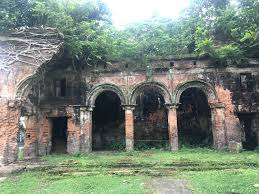Sukumar Ray’s House: The Cradle of Bengali Nonsense Literature-
Among the many literary treasures of Bengal, Sukumar Ray’s house stands as a beacon of imagination, laughter, and cultural brilliance. Tucked within the bustling lanes of Kolkata, this historic residence has witnessed the rise of three generations of literary legends — Upendrakishore Ray Chowdhury, Sukumar Ray, and Satyajit Ray. The house is not just a place of residence; it’s a living museum of Bengali literary history.
The Legacy of Sukumar Ray-
Born in 1887, Sukumar Ray was one of Bengal’s most celebrated poets and illustrators. Known for pioneering Bengali nonsense literature, his works like Abol Tabol, HaJaBaRaLa, and Pagla Dashu redefined children’s literature in the early 20th century. His genius lay in his ability to blend logic with absurdity, creating a whimsical world that appealed equally to children and adults.
Sukumar Ray was the son of Upendrakishore Ray Chowdhury, a renowned writer, scientist, and entrepreneur. Their home became the epicenter of literary creativity, where intellect and humor merged in the most delightful ways.
Location of Sukumar Ray’s House-
Sukumar Ray’s house was located at 100 A, Garpar Road in North Kolkata — once known as 210 Cornwallis Street. This house, owned by the Ray family, was more than just a shelter; it was a hub of cultural, literary, and intellectual exchanges. It is here that the famed Sandesh magazine was edited and published, bringing joy and knowledge to countless Bengali households.
Inside the House: A Literary Workshop-
The house was divided into various spaces for different creative purposes. The ground floor included a printing press, where the U. Ray and Sons publication house operated. This press was instrumental in publishing the Sandesh magazine, originally started by Upendrakishore Ray and later edited by Sukumar.
The upper floors served as the living quarters and the creative haven for the family. The wooden bookshelves, ink-stained desks, manuscripts, and original illustrations still echo the brilliance of the past. The house was a silent observer of Sukumar’s most innovative works — a blend of poetry, satire, and social commentary disguised under nonsensical humor.
Sandesh Magazine and the Role of Sukumar Ray’s House-
Launched in 1913, Sandesh magazine is an integral part of Sukumar Ray’s legacy. It was in this very house that the magazine took shape, catering to curious young minds and offering a mix of science, stories, puzzles, and poems. The publication reflected the Ray family’s commitment to nurturing intelligence and creativity among children.
Sukumar Ray revolutionized Sandesh with his unique illustrations and hilarious, insightful stories. The magazine was printed in the in-house press, and the living room of Sukumar’s house often turned into a vibrant editorial desk where he brainstormed content ideas with fellow writers and family members.
Architectural Significance-
Sukumar Ray’s house was built in the colonial style of the late 19th century. The building had high ceilings, arched doorways, wide verandas, and classic wooden railings — common in the homes of Bengali intelligentsia of that era. The house was both a home and a creative institution.
Each brick and beam seemed to carry the scent of old books and the echo of children’s laughter. The intricate grillwork and large windows provided ample light, inspiring an environment of learning and play.
The Cultural Importance of Sukumar Ray’s House-
This house was not just a home; it was the birthplace of Bengali children’s literature. Sukumar Ray’s use of intelligent humor and imaginative fantasy broke away from the didactic writing styles of his predecessors. Through his creations, children were introduced to a world where logic danced with absurdity, and imagination reigned supreme.
Many of the characters like Khuror Kol or Pagla Dashu were possibly inspired by people and moments from this very house. As a result, the structure gained a mythic stature in the Bengali literary imagination.
Satyajit Ray and His Connection to the House-
Satyajit Ray, Sukumar Ray’s only son, grew up in this house, influenced by its literary and artistic environment. The sense of creativity that Satyajit inherited can be traced directly to the ambiance of Sukumar Ray’s house, where storytelling was a daily ritual.
Satyajit later acknowledged how the absurdist humor of Abol Tabol and the meticulousness of the Sandesh editorial process shaped his own sensibilities as a filmmaker and writer.
The Decline and Hope for Restoration-
Over the years, the house has suffered from negl-ect. As family members moved away and priorities shifted, this literary landmark gradually faded into obscurity. Despite its significance, there is no formal effort yet from the government to preserve Sukumar Ray’s house as a heritage site.
Many in the literary community believe this house deserves to be restored and turned into a museum or research center, showcasing manuscripts, original copies of Sandesh, personal belongings of the Ray family, and more.
Why Sukumar Ray’s House Should Be Preserved-
- Literary value: The birthplace of nonsense literature in Bengal.
- Cultural identity: A reminder of Bengali intellectualism and creativity.
- Historical architecture: A specimen of colonial Bengali residential design.
- Educational resource: Perfect for literary studies and heritage tourism.
How to Reach Sukumar Ray’s House-
Though the house is not officially open to the public, it is located in North Kolkata, accessible by metro, bus, or taxi. Enthusiasts often visit the area to catch a glimpse and feel the aura of the place where some of Bengali literature’s greatest minds once lived and worked.
Conclusion-
Sukumar Ray’s house is more than a physical structure — it is a cultural relic, a spiritual home for Bengali literature lovers, and a place where laughter, learning, and literary excellence were nurtured under one roof. From editing children’s magazines to crafting absurdist poetry, this house was the backdrop of a literary revolution.
Preserving and promoting the significance of Sukumar Ray’s house is not just about saving a building — it is about honoring a legacy that continues to shape generations of readers, writers, and thinkers. Let this not remain a forgotten monument, but rather become a living archive of creativity and joy.
FAQs About Sukumar Ray’s House-
Where is Sukumar Ray’s house located?
Sukumar Ray’s house is located at 100A Garpar Road, North Kolkata, formerly known as 210 Cornwallis Street.
Who lived in Sukumar Ray’s house?
The house was home to three generations of the Ray family, including Upendrakishore Ray Chowdhury, Sukumar Ray, and Satyajit Ray.
Is Sukumar Ray’s house open to visitors?
Currently, it is a private residence and not officially open to the public, though literary enthusiasts often visit the location.
Why is Sukumar Ray’s house important?
It is the birthplace of Bengali children’s literature, where legendary works like Abol Tabol and the Sandesh magazine were created.
Can the house be turned into a museum?
Many literary advocates believe that with proper support, the house can be preserved and converted into a museum or literary center.
Did Satyajit Ray also live in this house?
Yes, Satyajit Ray spent his early years in this house, which had a profound influence on his creative development.













